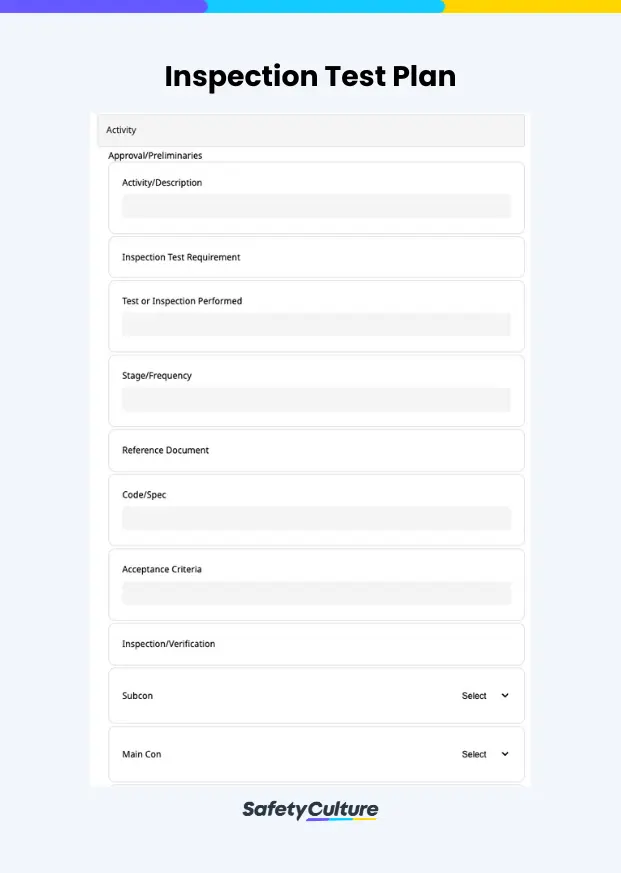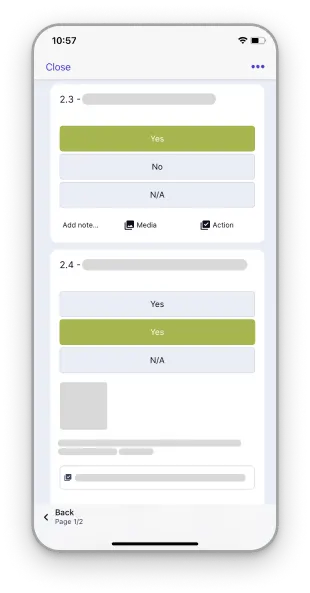What is an Inspection Test Plan?
An inspection test plan (ITP) is a project document that is usually prepared by a quality engineer. It sets down the program of inspections, tests, and surveys needed for each specified work or materials of the project. Having an inspection test plan protects the business from costly mistakes, and ensures the consistency and quality of the project output. It also satisfies the requirements stated in the ISO 9001 standard in relation to control of production and service provision.
5 Construction Pitfalls that are Avoided with an Inspection and Test Plan
Health and safety is a serious issue in the construction industry. In 2018, there are a reported number of 1,008 fatal work injuries in construction in the US. This is why it’s integral for construction businesses to establish safety programs, to ensure safety and the quality of the project. Below are 5 of the common pitfalls that construction businesses face:
Failure to identify problem areas early
Construction work has critical components or difficult parts. Project managers should be able to identify the risks that come along each task to be performed for the completion of the project. Risks should be identified beforehand, to help project managers address them before they occur and lead to costly incidents.
Failure to stick with the schedule
Scheduling plays an integral part in the successful completion of a project. Without proper scheduling in place, things may get muddled between renting equipment, bringing in subcontractors, ordering supplies, getting permits, performing required inspections, tests, and surveys.
Going over the budget
Projects tend to exceed the budget for many reasons. Projects mainly go over the budget due to these three main reasons: 1) no one is accountable for the budget; 2) the project drags past the deadline; and 3) the project falls or goes beyond the boundaries set for the scope of the project. While some other reasons are unexpected, a lot of these can actually be foreseen and addressed to minimize the amount of overage.
Not Securing All Required Construction Permits
Permits ensure safety and enforce proper safety standards that assure protection not only for the client or occupants of the space, but for the workers as well. It also aids in keeping your insurance valid should an injury or accident occur. Acquiring permits can be such a lengthy process, which is why It is of the utmost importance that the needed permits for the project are set out and established beforehand, to prevent disruption to the project timeline.
Inadequate Supervision
Due to the amount of work that needs to be done, a lot of the project’s important steps tend to get overlooked. Inadequate supervision not only opens risks for reworks due to construction defects but also opens the possibility for injuries and accidents.
These pitfalls can be easily avoided if a quality system such as an inspection and test plan is present. It is good practice to have one prepared before starting the works as it will provide the construction business and its client a clear and concise plan in managing inspection and test activities that will provide quality assurance, control, and documented evidence of constructed works.
6 Best Practices in Writing an Inspection Test Plan (ITP)
To help construction businesses provide a clear guide on the “when,” “what,” and “how” of the inspections using an inspection test plan, we have outlined 6 best practices in writing it down:
1. List down activity and task inspections
In writing an inspection test plan, the work activities should be written chronologically. Better yet following the sequence of works described in the method statement. Under each activity, provide the appropriate description by putting in the succeeding inspections.
For example:
| Activity/Description | Test or Inspection performed | Stage / Frequency | Code / Spec |
| Excavation | |||
|
|||
|
2. Include code and reference documents
Each inspection will have different requirements or standards to meet. An inspection test plan must be able to clearly reference these documents. Code and standards are commonly referenced to the following:
- Contract documents/specification
- Contract drawings
- Approved workshop drawings and/or calculations
- Regulatory requirements
- International standards
- Manufacturers’ recommendations
For example:
| Activity/Description | Test or Inspection performed | Stage / Frequency | Code / Spec |
| Excavation | |||
|
Specification section 02 Clause 0000 |
On the inspection and test plan form, also indicate the reference numbers to the documents that will serve as evidence to verify the inspection. This is usually written in the last column of the form.
For Example:
| Activity/Description | Test or Inspection performed | Stage / Frequency | Code / Spec | Inspection / Verification | Verifying Documents List | ||
| Sub Con | Main Con | Employer | |||||
| Excavation | |||||||
|
Specification section 02 Clause 0000 | Approved drawing, Method Statement DTF-D-001 | |||||
3. Set the inspection criteria
In the inspection or verification section of the inspection test plan, the contractor, consultant or engineer, and client or employer will be involved. The parties involved should determine their responsibilities based on the inspection process criteria, and it should be done before works start, to avoid confusion and compromises. Below is the inspection process criteria for every inspection plan item:
- Surveillance (S) – this means attendance on site can be random and that there is no need for signature on the inspection request or its accompanying documentation.
- Execution (E) – this means attendance on site is required, and signature is always on the inspection request and checklist.
- Witness (W) – this means that attendance is expected on site, and that a signature will be required on the inspection request and checklist. In any case that the signatory is not present, they may follow up on the work and proceed with the work and sign the document(s) later.
- Hold Point (H) – this refers to attendance on site being mandatory, and requiring a signature on the check sheet of the inspection request during the inspection to release the following work.
- Review (R) – this pertains to documents to be reviewed. No signature is needed on the inspection request or any of its accompanying document(s).
- Records (RE) – this means documentation to be recorded. No signature will be required on the inspection request or any of its accompanying document(s).
To give you an idea of what it would look like, here is an example:
| Activity/Description | Test or Inspection performed | Stage / Frequency | Code / Spec | Inspection / Verification | ||
| Sub Con | Main Con | Employer | ||||
| Excavation | ||||||
|
E | W | R | |||
4. Setting the acceptance criteria
The acceptance criteria will be the basis of how a certain task will be approved or accepted. It is usually defined in the inspection plan directly or in reference to standards such as the International Codes and Standards. Acceptance criteria can also be based on the agreement between the client/employer.
To give you an idea, here are some examples of what it would look like:
| Activity/Description | Test or Inspection performed | Stage / Frequency | Code / Spec | Acceptance Criteria |
| Material Inspections (Delivery on site ) | ||||
|
||||
|
|
| Activity/Description | Test or Inspection performed | Stage / Frequency | Code / Spec | Acceptance Criteria |
| Excavation | ||||
|
|
5. Accompany Inspections Plan with a Checklist
An inspection checklist is usually attached to the inspection request. Inspection and test plan checklists are designed to assist customers in assessing the contractor’s ITP. It indicates checks done in each work area before and during the inspection.
6. Use an Inspection Test Plan (ITP) Template
Cut down on the time spent in doing the documentation from scratch. Use a ready-made and ready-to-use inspection test plan template. Templates can help give you a good idea of the structure and approach, and you can customize them easily according to your business needs.
See how a UK based construction company, Pochin Construction, improves its safety culture by setting up an easy to use template in the SafetyCulture (formerly iAuditor) system in the video:



